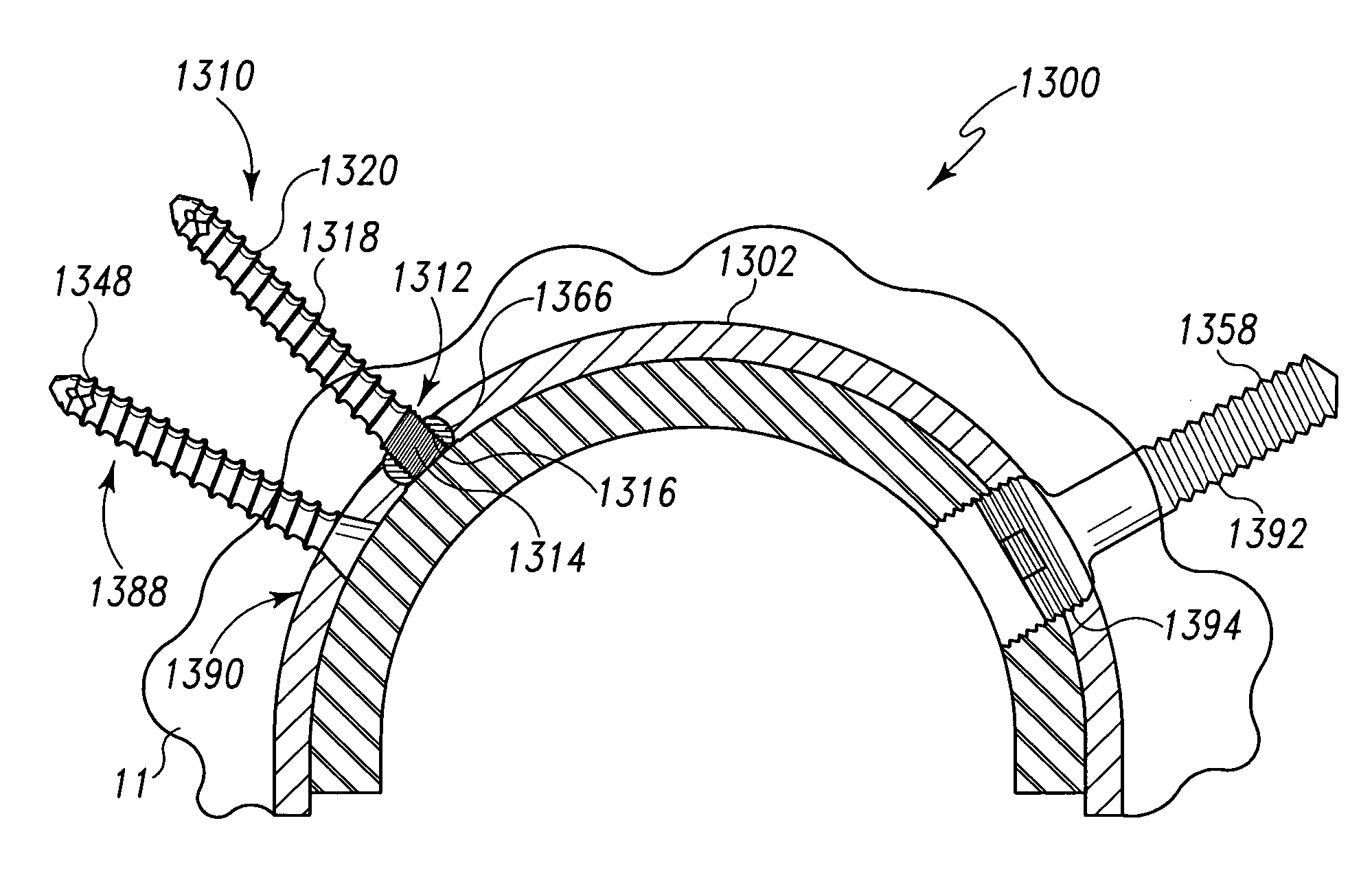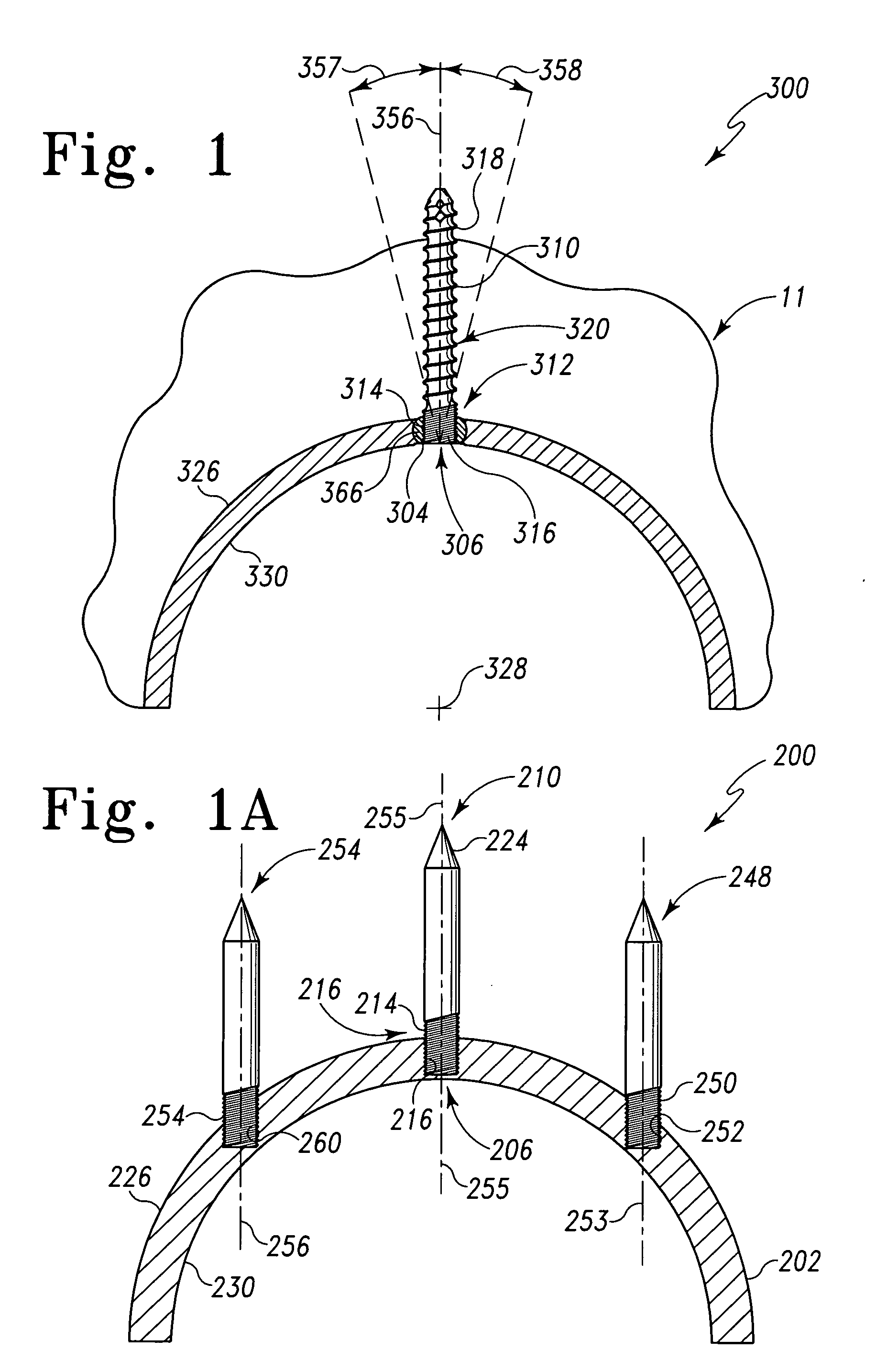[0020] The locking
orthopaedic implant of the
assembly may include a screw that locks to the acetabular reconstruction device in a single orientation relative to the device. Alternatively, the
fastener may be in the form of a screw or a pin that may lock to the reconstruction device in any one of infinite orientations with respect to the device. Such variable orientations of a locking fastener may be accomplished by one of many devices such as by using polyaxial
bushing technology. The polyaxial
bushing has a generally spherical outer
diameter “OD” and a tapered cylindrical inner
diameter “ID.” The
bushing is split readily so that it may compress upon the
insertion of a fastener through the tapered bore. The fastener expands the tapered bore causing the spherical periphery of the bushing to lockably engage with the spherical bore on the
orthopaedic implant.
[0034] The technical advantages of the present invention further include the ability to provide better fixation if significant defects are found in the bone adjoining the orthopaedic
joint implant. For example, according to another aspect of the present invention, an orthopaedic joint
assembly for attachment to a bone is provided. The joint assembly includes a body having an
anterior wall defining an opening in the body. The joint assembly also includes a fastener having a portion of the fastener fitted through the opening of the body. The fastener is rigidly connected to the body. Thus the present invention provides for better fixation if significant defects occur by permitting the fastener to better support the body by being rigidly attached to the body.
[0035] The technical advantages of the present invention also include an ability to provide better fixation to
poor quality bone. For example, according to another aspect of the present invention, an orthopaedic joint assembly for attachment to bone is provided. The joint assembly includes an orthopaedic
joint component having an interior wall defining an opening in the body. The joint assembly also includes a fastener having a portion fitted through the opening of the orthopaedic
joint component. The fastener is rigidly connected to the orthopaedic
joint component. Thus the present invention provides for better fixation of the
orthopaedic implant component to bone when
poor quality bone is positioned near the joint.
[0036] The technical advantages of the present invention also include the ability to provide more options to achieve
bone fixation in sub-optimum bone conditions, where the patient may have good
bone quality in certain locations and poor
bone quality in other locations. For example, according to another aspect of the present invention, an orthopaedic joint component is provided for attachment to a bone. The orthopaedic joint component has an interior wall defining an opening in the component. The joint assembly also includes a fastener having a portion rigidly connected to the body in a selected one of a plurality of angular positions relative to the orthopaedic component. Thus the present invention provides for more options to achieve
bone fixation by permitting the fastener to be rigidly positioned in one of several positions in order that the fastener is aligned with better quality bone rather than with poor quality bone.
[0037] The technical advantages of the present invention also include the ability to keep the orthopaedic joint component stable. For example, according to another aspect of the present invention, an orthopaedic joint assembly for attachment to bone is provided. The joint assembly includes an orthopaedic joint component having an interior wall defining a component opening in the component. The joint assembly also includes a fastener having a portion of the fastener fitted through the opening of the component. The fastener is rigidly connected to the component. Thus the present invention provides for a rigid fastener to keep the acetabular device stable in the bone.
[0038] The technical advantages of the present invention further include the ability to compensate for the
resorption of bone over time behind the orthopaedic joint component. For example, according to another aspect of the present invention, an. orthopaedic joint assembly is provided for attachment to a bone. The joint assembly includes a joint component having an interior wall defining an opening in the joint component. The joint assembly also includes a fastener having a portion of the fastener fitted through the opening of the component. The fastener is rigidly connected to the component providing a rigid construct that provides support for the orthopaedic joint component when
resorption of bone around the component occurs.
 Login to View More
Login to View More  Login to View More
Login to View More 


